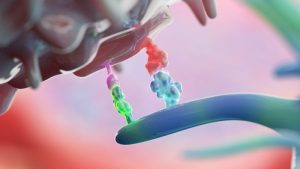PUBLICATION
Melissa T. Bu, Long Yuan, Alyssa N. Klee, and Gordon J. Freeman, A Comparison of Murine PD-1 and PD-L1 Monoclonal Antibodies, published in Monoclonal Antibodies in Immunodiagnosis and Therapy.
PUBLICATION SUMMARY

Immunotherapy utilizing blockade of the PD-L1/PD-1 pathway has significantly impacted the treatment of cancer. Experimental models play a pivotal role in preclinical research, allowing scientists to answer questions about this important pathway and explore therapeutic combinations. Several murine antibodies are routinely used in this research. Gordon Freeman and his team at Dana-Faber Cancer Institute compared commonly used PD-L1 and PD-1 antibodies, including 10F.9G2, MIH6, 29F.1A12, RMP1-14, and RMP1-30.
The team began their experiments by comparing two frequently used PD-L1 antibodies in mouse models, mAbs 10F.9G2 and MIH6. Their testing showed that 10F.9G2 and MIH6 are nearly equivalent antibodies with a similar ability to bind cells transfected with mouse PD-L1 and to block the binding of PD-1 and CD80 to PD-L1 transfected cells. Additionally, these antibodies showed similar ability to block PD-L1/ PD-1 mediated inhibition of T cell activation.
The researchers next turned their attention to 29F.1A12 and RPM1-14, two anti-mouse PD-1 antibodies commonly used in mouse models. Although both antibodies are frequently used for in vivo blocking of PD-1 signaling, 29F.1A12 is also commonly utilized for in vitro applications. When tested for their ability to bind to cells transfected with mouse PD-1, the 29F.1A12 antibody demonstrated a stronger affinity than RPMI-14 (0.42nM vs 28.8nM). The antibodies were next tested for their ability to block the binding of PD-L1 or PD-L2 to PD-1. Although both antibodies were able to block binding, 29F.1A12 was effective at a lower concentration, again demonstrating the higher avidity of this antibody.
How To Choose An Anti-PD-1 Antibody For Your Research
Next, 10F.9G2, 29F.1A12, RMPI-14, and RMP1-30 were all tested for their ability to reverse PD-1-mediated inhibition of TCR/CD28 signaling in a cell-based model. The results showed that PD-1 and PD-L1 antibodies can reverse inhibitory signaling in proportion with their ability to block the binding of PD-L1 to PD-1, with 10F.9G2 and 29F.1A12 being the most effective at lower concentrations, RMP1-14 reversing inhibitory signal at a higher concentration and RMP1-30 being unable to block PD-L1/ PD-1 interaction.
Lastly, blocking studies on PD-1 antibodies revealed that RMP1-30 can be used to stain PD-1 in experiments using 29F.1A12 or RMP1-14 with a reduction in fluorescence activity if the therapeutic antibody is bound to PD-1.
The authors conclude that experiments with 29F.1A12 most closely model human PD-1 therapeutic antibodies, which have a high affinity and blocking ability. They also caution that using RMP1-14 in combination therapy experiments may reduce PD-1 blockade compared to 29F.1A12. This work furthers the characterization of frequently used antibodies in studying immune checkpoint blockade and paves the way for the continued evolution of murine models.
FEATURED PRODUCTS:
The following Bio X Cell antibodies were featured in the publication:
- InVivoPlus anti-mouse PD-L1 (B7-H1), Clone:10F.9G2™, Catalog: BP0101
- InVivoPlus anti-mouse PD-1 (CD279), Clone: RMP1-14, Catalog: BP0146
- InVivoPlus anti-mouse PD-1 (CD279), Clone: 29F.1A12™, Catalog: BP0273
- InVivoMAb anti-human CD28, Clone: 9.3, Catalog: BE0248
- InVivoPlus rat IgG2b isotype control, anti-keyhole limpet hemocyanin, Clone: LTF-2, Catalog: BP0090
- InVivoPlus rat IgG2a isotype control, anti-trinitrophenol, Clone: 2A3, Catalog #BP0089



